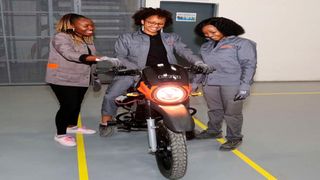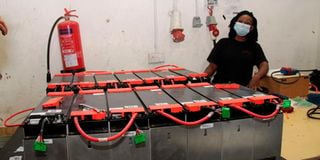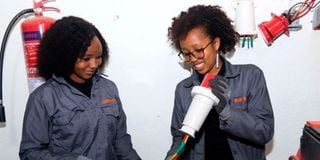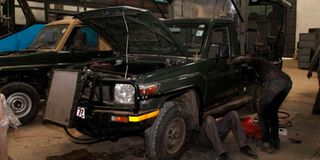
From left: Lucy Mugula (mechanical engineer) Beatrice Wanjiru (electrical engineer) and Esther Wairimu (mechanical engineer) working on an electric motorbike.
| Lucy Wanjiru | Nation Media GroupLifestyle
Premium
‘Power girls’ who tear down vehicles, make them electric
Electric vehicles are taking the world by storm and in Kenya, young women engineers are at the centre of this revolution; converting fuel car engines to electric ones.
At Opibus, an international company headquartered in Nairobi, we caught up with some of the young engineers at whose orders, electric currents flow meaningfully in tens of cars, and the result? Zero emissions, less noise pollution and little operation costs compared to vehicles that use fossil fuel.
Covered in their grey overalls, 24-year-old electrical engineer Beatrice Wanjiru, mechatronics engineer Lucy Mugala, 27, and mechanical engineer Esther Wairimu, 26, disappear behind huge sets of machinery and do what many would think is moving mountains, but to them it is just another day’s work.
“Most people think that disassembling a vehicle is very complex. But I find it very simple, for instance, to remove and re-install a car engine. You only need to employ some very basic tools and you’re good for the job,” says Esther, who works in the production department.
As the local industry increasingly adopts electric cars, the engineers have been busy installing the system, mostly on high-utility automobiles such as safari cars and buses at an initial cost of Sh4 million ($39,000).
The automakers, located in the industrial hub on Mombasa Road, also build Opibus-branded motorbikes from scratch. They are now working on three-wheelers commonly known as tuk tuks as they advance their pilot programme targeting the lucrative public service vehicles that has an upwards of 25,000 vehicles.
“We also sell solar panels and battery packs which are used as back-up systems by the safari cars in case the battery runs low while in the Maasai Mara or any other destination,” says Beatrice, who works directly under the pilot programme targeting to fit matatus with the electric system.
The trio speak so passionately of a sector only conquered by a few in the world. They have at their fingertips every single detail of what changing an internal combustion engine to an electric one entails.
So, what happens when a client deposits their car at their garage for conversion?

From left: Lucy Mugula, Esther Wairimu and Beatrice Wanjiru testing tuk tuk batteries on August 2, 2021.
Lucy, who works in the Research and Development department, says a car should meet the minimum requirement before they embark on removing the entire fossil fuel system — the engine, fuel tank, gear system and exhaust pipe. Those are replaced with their prepared electric sets.
“The electric battery pack replaces the fuel tank, motor replaces engine, and controller replaces the electrical circuit unit of the fossil fuel cars,” she explains. But the actual conversion is a walk in the park and could take only two days, compared to the preparation or design process of these electric parts — which the engineers say is the toughest bit of the job.
“When coming up with a new product, sometimes we have to source components one by one. You have to choose a motor with the right ratings, ensure the battery pack matches the motor and that the controller has suitable requirements. You have to come up with a wiring system for the entire car and fix it manually,” says Lucy.
Also built from the scratch are the battery compartments, controller housing and mounting of the motor.
Utility vehicles that carry heavy loads and manoeuvre treacherous terrains have special requirements of a bigger battery size due to the energy required to move them. However, the cost remains the same since no extra materials are needed; only adjustment of settings.
Multifunctional vehicles are also designed for clients who need to occasionally shift from the smooth city tarmacs to the rough village terrain. The settings are made from an average of different data findings so they can shift the gears whenever, just as in ordinary vehicles.
“There are gears also in the electronic system. They work with different current requirements. When you shift a gear from one to two, you’re telling the motor to draw more current so you can generate power to drive along a rougher terrain,” Lucy explains.
The more the current, the faster the battery is depleted.

Ashley Mutheu, an electric engineer at Opibus, at the firm on March 29, 2021.
On average, the battery runs for 100 kilometres, and up to 120 kilometres for a bike. For both, the speed of depletion of the battery depends on the terrain and driving styles of the driver. Generally, fast driving consumes more battery.
Thanks to the advancement of engineering and its tools, the youngsters are able to go under or over massive automotives like buses and dismantle them, then rebuild any aspect that would previously require masculinity to achieve.
“We have a lot of power tools. You don’t need to work hard, but smart. For example, there could be a bolt that is very tight and you find that with a normal range you can’t open it. You don’t need to have someone strong to open it for you; you just need an extension or something longer to lower the amount of energy,” Esther explains.
When the young professionals emerge with their tools and aprons, it’s easy for anyone who doesn’t know them, clients included, to write them off at face value. Although they don’t directly interact with clients because the marketing department delivers vehicles to work on, it’s sometimes inevitable to meet, like when the time comes to deliver the fully electrified vehicle.
They narrated how men and women stare at them with question marks, size them up and pose “tough” questions in a bid to gauge their knowledge in the field.
“Clients are always excited with the idea of electric conversion and they get fascinated when they see a young lady emerge to do it,” Beatrice said.
Esther added: “People expect engineers to be big men in suits and older. But most of us, men included, are in their early 20s. It’s common for anyone who is investing large sums of money to a company to want to be sure of the people who are handling their products.”
Esther, who has a diploma in mechanical engineering production at Kabete Polytechnic, was the first female engineer employed in the start-up in January 2018.
She says her male colleagues were very receptive. All she had to do was prove her competence. She is now living her dream.
Three years down the line, 40 per cent of the 88 employees at the company are women.
Drive for equality
Opibus marketing manager Albin Wilson says the vision of the company revolves around not only working for a better environment by reducing carbon emissions, but also changing the culture to a more gender-sensitive one.

Opibus Mechanical engineer Esther Wairimu (left) with Beatrice Wanjiru an Electrical engineer on August 2, 2021.
“Equality between the genders means we will design better products for everyone, having in mind the masses and their various needs. That makes us more effective in business,” Albin says, adding that although gender equality is rare in technology companies and especially the automotive sector, they want to lead the way.
The young engineers at Opibus have experienced first-hand what experts say about start-ups being a good breeding ground for careers. Unhindered, they pitch new ideas and get the support to experiment. With every trial, they always emerge with a positive outcome, because even in the event that a test or two fail, they pick the lessons and way forward and are off to a more successful start.
That freedom, they say, is the wind beneath every successful engineer’s wings.
Beatrice appreciates the working environment at Opibus where they set a trend for a massive technology projects, much more than the traditional, long established parastatal where she did her internship after graduating from the Jomo Kenyatta University of Agriculture and Technology (JKuat).
“Opibus is a start-up, but my set of experiences here are much more than any other place I have worked at before. You get a chance to set a trend in a new technology and help our country venture into a new space,” Beatrice says.
She would still want to be in the electric mobility sector 10 years from now, doing policy-making towards improving the uptake of the technology in the country.

Opibus engineers installing an electric battery to a vehicle on March 29, 2021 in Embakasi, Nairobi.
Battery technology holds the biggest challenge within the electric cars space all over the world. And as Tesla — the famous electric vehicle company based in the United States — grapples with making batteries that run longer, the youngsters at Opibus are also testing their locally designed engines for the same, albeit on a smaller scale.
Among those being tested are battery packs for an electric tuk tuk. The engineers designed the batteries themselves.
“Here, we’re testing the charging system; whether the chargers and the battery management system communicate. It should cut off power when fully charged and start charging automatically when very low. These batteries are very sensitive and you have to cut power at a certain point or they’ll be damaged. At the moment, we have to control them,” Beatrice explained.
It’s a prototype whose modules the team designed then sent them to a supplier who built them in China and shipped them in for the rest of the parts to be fixed. One of the areas to be fixed is making the charger “obedient”.
To solve the battery depletion challenge, bikes already have extra swappable batteries and portable chargers that can be plugged into a power source, just like mobile phones. This is a timely solution as they work towards developing batteries that have more energy while maintaining the cost of the bikes.
Building prototype
The JKuat graduate explains that a development engineer is always on the test bench. They look at what the market needs and do product enhancement or create new ones.
“Product development involves a lot of design work, reviews and testing. Most times, I am on a test bench testing something on building a prototype. It’s really exciting,” Lucy noted.
Her passion is using her mechatronics knowledge to solve environment-related problems. Among her projects is a machine used to bale or package waste bottles to ease the cost of transportation. It’s the innovation that led her to another green energy project at Opibus.
“I want to challenge the status quo and use my skills to tackle environmental problems from the grassroots by changing lifestyles,” Lucy says.
Electric mobility was not part of what the three engineers learnt in school, but they applied the same engineering principles and learnt other aspects on the job. The everyday learning experience on the new technology is priceless to them.
It is for that reason that they hope to mentor other young women to take the less-travelled road.





